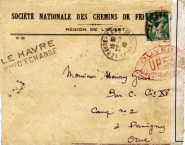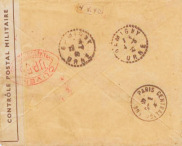Built during second half of 1939 on a ground of almost three hectares located in edge of the road of COLOMBIERS, the INTERNMENT CAMP N° 2 of DAMIGNY would have functioned from December 1939 to May 1940.
It sheltered the "undesirable ones", German refugees and ex-Austrians mainly of Jewish confession, having fled the Nazi regime. They were 863 in May 1940, time of the closing of the camp, none of all receiving benefits, i.e. nonaffected to companies of immigrant workers.
The CAMP OF DAMIGNY had in particular received Jewish refugees of the steamer "SAINT-LOUIS" driven back of Cuba in June 1939 and having found asylum in France.
The first prisoners of DAMIGNY would have taken part in the construction of a road connecting COLOMBIERS to that of ARGENTAN. Then, at the beginning of the German offensive of 1940, some soldiers of Wehrmacht were there prisoners until the arrival of the troops of occupation.
Unoccupied then during a month, the camp would have been used as warehouse of German military material then of stables gathering the horses having belonged to the French Army.
In April 1943, a new assignment is given to him with the detention of refractories to the S.T.O., resistant or suspect men of the maquis.
After the unloading of June 1944, American parachutists and English would have been held there until the abandonment of the camp, August 11, 1944, by the Germans.
In fact then the Allies will take possession of it to shelter there German prisoners which the last will leave only in October 1948. (Deposit of Prisoners of war of the Axis n° 31). Then, all the installations will be sold and the returned ground with agriculture (OUEST-FRANCE 16-8-2004).
The letter illustrating this article is of great interest. It was addressed HAVRE-GARE on April 27, 1940 by S.N.C.F. to Henry GRASS, German refugee in France, internee with the Camp n° 2 of DAMIGNY (Orne).

Letter from LE HAVRE dated 27-4-1940, addressed to a German internee
in the CAMP OF DAMIGNY (Orne). (recto)

It should be noted that the internee Henry GRASS was still with DAMIGNY on May 4 and that he was transferred little from days after to the CAMP OF BASSENS (Gironde) where its presence is attested on May 15, 1940 (see the document illustrating this camp). II is probable that the totality of the internees of DAMIGNY knew the same fate.
The routing of this letter is at the very least curious! Indeed, left LE HAVRE-GARE on April 27, 1940, it arrived at DAMIGNY on April 29 (seal of arrival to the back). Then, it was transmitted to the military postal supervising authority of PARIS treating at that time the mail dice prisoner of war, which closed again the envelope by means of a gummed band comprising the mention CONTROLE POSTAL MILITAIRE and affixed the red seal OUVERT PAR L'AUTORITE MILITAIRE UP 53. The letter forwarded then by the office of PARIS CENTRALISATEUR on May 3, 1940. This service having functioned during the Second World war was intended to facilitate the transit of the correspondences and in particular the exchange of mail between the Chamber of Commerce.
Lastly, May 4, 1940, the letter arrived for the second time at DAMIGNY and was given to its recipient.

The mark LE HAVRE BEAU D'ECHANGE affixed with the recto does not seem to be postal but rather to belong to S.N.C.F., the French Railway Company.
Having vainly asked S.N.C.F about the origin of this seal, I questioned my colleagues of the "Cercle d'Etudes Marcophiles et Philatéliques de Normandie".
Thanks to Mr PATARD, I obtained the following information from a member of the "Association des Modélistes Havrais", specialist on the matter:
"The office of exchange was a service of the SNCF. It was located at Le Havre, near the Jean-Jacques Rousseau bridge and the gas works. A railway allowed the routing of three coaches.
"This office received the parcels, letters and various low volume goods destinated to or coming from Martinique, Guadeloupe, St Pierre-and-Miquelon, etc. Parcels and letters received the seal OFFICE Of EXCHANGE. Then thry were put out of bags and leaded by the customs which had a counter on the spot.
"This office had the nickname of CAYENNE because it was ensured by railwaymen in punishment for professional misconduct during three or six months. Work was painful there and under the authority of very severe departmental managers. They worked at the day instead of per quarter. Manpower was from 8 to 10 railwaymen permanently. It varied according to the volume of goods.
"This service disappeared with the end of cargo liners and the arrival of containers. Today, only the way remains."
As for the presence of this seal on a letter from SNCF and addressed to a German internee, without knowing its contents, we can only try an interpretation.
Would this German refugee have been affected to this service as provider?
We have to recall indeed that the law of April 12th, 1939 had decided the
incorporation in regular units of mobilizable foreigners, as provider.
Other measures taken by the staff foresaw that in case of mobilization, all
the male foreigners from 17 to 50 years old would be concentrated in gathering
centers and then divided into units of workers to the service of military
regions or public services.
A circular letter dated August 30th, 1939 specified that the foreigners considered as “undesirable” would not be any more authorized to work for National defense and would be treated as prisoners of war.
Can this provision explain the intervention of the "Commission de Censure U P de PARIS" (PRISONERS OF WAR) which would have had to control the mail destinated to these internees?
19/12/2009

